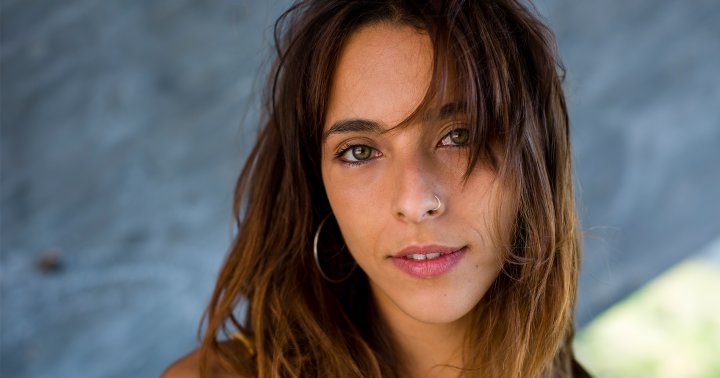Utthita Trikonasana: Harnessing Strength and Flexibility in Triangle Pose
The post Utthita Trikonasana: Harnessing Strength and Flexibility in Triangle Pose appeared first on The Yoga Nomads.
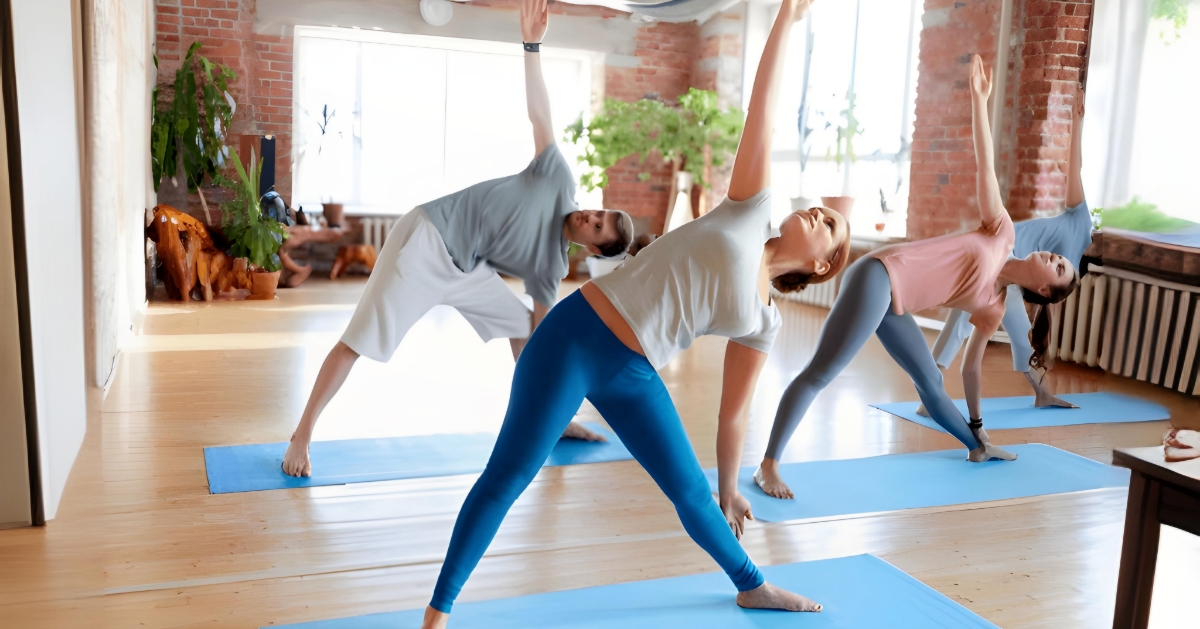
Key Takeaway
Utthita Trikonasana, or Extended Triangle Pose is a classic yoga asana that offers numerous benefits such as enhanced balance and stability and improve flexibility. Follow the step-by-step instructions and tips provided here to achieve proper alignment and build confidence in this pose.
At the beginning of my yoga journey, I recall Utthita Trikonasana, or Triangle Pose, as one of the first yoga poses that truly challenged me.
Now, as a yoga teacher, I can understand why. This intermediate-level standing pose combines many different skills and complex alignment for a dynamic and often intense experience. This posture requires a unique balance of many complementary qualities: strength and flexibility, grounding and expansiveness, and determination and poise.
Of course, proper alignment is crucial in every asana. However, my experience has taught me that mastering Utthita Trikonasana is not just about achieving a physical stance but cultivating balance in every breath.
So, let’s explore how this powerful pose can transform your yoga practice, fostering an unparalleled sense of grounding and openness.
Watch our recommended steps for entering, holding, and exiting the triangle pose.
Utthita Trikonasana Origins and Sanskrit Name and Origins
Modern Roots
We can trace the origins of Utthita Trikonasana to the 20th century in T. Krishnamacharya’s 1934 text Yoga Makaranda. Today, many teachers consider this asana a foundational yoga pose symbolizing stability and strength and embodying the balance between mind and body central to yoga philosophy.
Sanskrit Name Breakdown
The Sanskrit name Utthita Trikonasana translates to Extended Triangle Pose. This name gives us a clear picture of the pose’s shape and intention.
Utthita means “extended,” suggesting a stretching or reaching out. Trikona translates to “triangular,” describing the geometric form taken by the body. Asana is a suffix indicating “pose” or “posture” within yoga practices.When combined, Utthita Trikonasana describes a pose resembling an extended triangle shape.
Step-by-Step Guide to Practicing Utthita Trikonasana
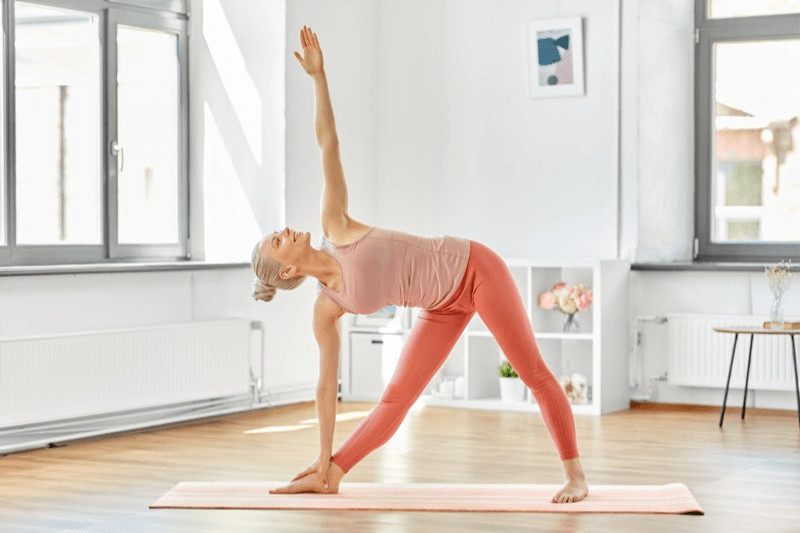
Utthita Trikonasana is an intermediate-level standing pose that challenges strength and balance. Following these step-by-step instructions will help you achieve proper alignment.
Starting Position
To begin practicing Utthita Trikonasana, or Triangle Pose, first create a stable base with your lower body.
Stand with your feet separated wide apart, a bit more than hip-width distance. Turn your right foot outwards 90 degrees and align the heel of your right foot with the arch of your left foot. Turn your left foot about 45 degrees to the right and ground down through the outer pinky-toe edge of your foot.Extend and Bend
Extend your arms parallel to the floor, palms facing down. Reach your right arm forward, lengthening from the sides of your body. Your fingertips should extend over your right foot. This step helps you keep a long spine. Engage your core and hinge from your waist, folding over your extended right leg while reaching your right hand toward your ankle. Place your right hand on the floor behind your right leg, or rest your hand on your right shin.Finishing Touches
Extend your left arm toward the ceiling. Your arms should create one straight line. At first, keep your head aligned with your spine, with your left temple facing the ceiling. To challenge your balance, turn your head toward your extended left hand. Keep your breath flowing as you hold your Triangle Pose for 30 seconds to one minute.Exiting Safely
When you’re ready to come out of the pose, press down through each heel to activate your inner thigh muscles. Rise up, lifting your torso using your abdominal oblique muscles. Return to your starting position.
Then, shift your stance and repeat Utthita Trikonasana with your left foot in front, bending over your left leg with your right arm reaching up.
Contraindications and Modifications for Beginners
Utthita Trikonasana engages the whole body with dynamic movement. People experiencing the following issues should use modifications or perhaps skip the pose altogether.
Injury to the ankle, knee, hamstrings, shoulder, spine, or neck. If you have chronic pain or have had recent surgery in any of those areas, be sure you consult with a medical professional before attempting Triangle Pose. Dizziness due to vertigo or low blood pressure. If your doctor approves, you may use a prop such as a chair or wall for stability. 2nd or 3rd trimester of pregnancy. The belly weight may cause balance issues and place too much strain on the back muscles.Using Props for Support
Props can help you build strength and confidence while learning a new pose.
Yoga block: Use a block under your lower hand if you can’t reach the floor. It brings the ground closer to you, making maintaining proper alignment and balance easier. The great thing about using a block is choosing an appropriate height by changing its orientation. Chair: For a gentler version of Triangle, set a chair just behind your front foot with the seat facing you. As you bend over your front leg, place your front hand on the chair’s seat. Wall: Set up with the toes of your front foot touching a wall. Reach forward and place your front hand on the wall. Lean toward the wall, pressing your palm firmly against it as you reach your opposite arm up. This modification is helpful for people with limited mobility or balance issues.
lululemon’s Lift and Lengthen Yoga Block
Modified Body Position
Tight hamstrings: Keep a micro-bend in the front knee to reduce excess strain. This modification also helps prevent back pain by aligning the spine better during the pose. Shoulder mobility: If you have tight shoulders or limited mobility, bring your top hand to your hip instead of reaching up toward the ceiling. Neck comfort: I prefer to gaze straight ahead rather than toward my top hand. It feels more comfortable and reduces strain on my neck muscles.From my experience, incorporating modifications like using a block or adjusting my gaze allows me to enjoy Utthita Trikonasana without discomfort, highlighting how minor adjustments can enhance one’s yoga journey.
Alignment Tips to Prevent Common Mistakes
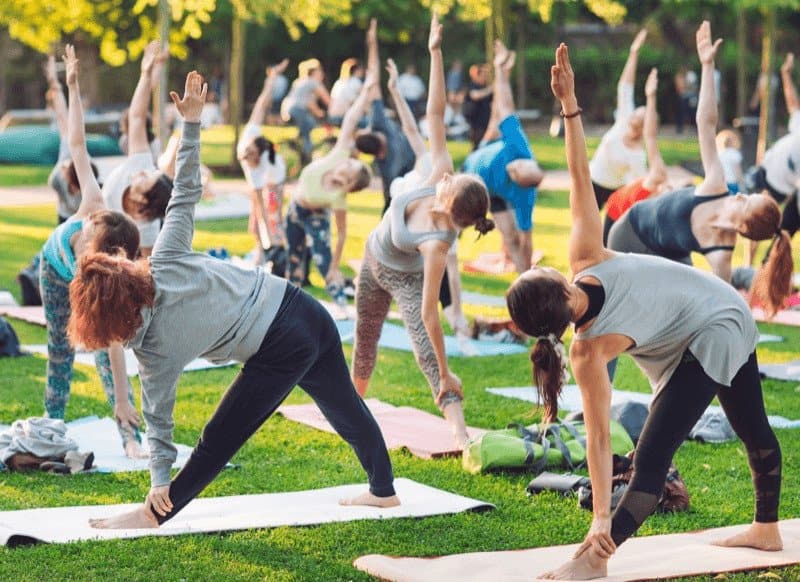
Proper Alignment
Proper alignment in Utthita Trikonasana is crucial to the pose’s integrity. As with all yoga poses, your focus should be on the intended effect of the asana rather than creating a picture-perfect shape.
Remember that everyone’s body proportions are unique so that proper alignment might look different from person to person. Use your body awareness to achieve optimal alignment rather than compare your Triangle Pose to someone else.
Common Mistakes
Extended Triangle Pose requires a balance of strength and flexibility, making this pose challenging for beginners. Here are some of the most common mistakes I see in Utthita Trikonasana and how to fix them.
Sinking chest: Your chest should be open and lifted in Triangle Pose. To avoid this common mistake, imagine widening your collarbones across the front of your chest. Rounded top shoulder: Visualize your top shoulder stacked directly over the other, making a vertical line. To do this, press the floor (or block) away with your bottom hand and engage your upper back muscles to draw your shoulder blades down your back. Uneven hip alignment: If your top hip rolls forward, you’re likely not engaging your back leg properly. Ground down through the outer edge of your back foot to lift your top hip and press it back so your hips are vertical. Curved spine: Even as you bend over your front leg, maintain a long spine. Triangle Pose utilizes lateral flexion in the spine instead of a forward fold. Collapsed sides: Another common mistake is collapsing in the waist once you fold over your front leg. Keep lengthening through the sides of your rib cage, engaging your oblique abdominal muscles. Bent neck: Use your neck muscles to align your head with your spine. If you let your head drop, you put excess strain on your neck. Locked knees: Your legs should be straight in Triangle Pose, but don’t lock your knees as it could cause pain in the knee joint. Instead, keep a micro-bend in both knees.By focusing on these alignment tips and avoiding common mistakes, you can enhance their experience of Utthita Trikonasana while minimizing the risk of injury. Remember that practicing yoga is about personal growth and body awareness — not achieving perfection on day one.
Enhancing Balance and Stability in Utthita Trikonasana
As a beginner, I found maintaining balance in Triangle Pose challenging. Here are a few tips that helped me achieve better stability.
Grounding through the feet: Stability starts with a strong base. Focus on pressing the outer edge of your back foot into the floor, and lift the inner arches of both feet. Core engagement: In most yoga poses, the first step to maintaining balance is engaging your core muscles. By pressing your navel towards your spine, you cultivate posture and poise, making it easier to hold the pose without swaying. Visualization Technique: Use the geometric shape of Triangle Pose to improve your alignment. Visualize your body in vertical lines: hips stacked vertically, shoulders aligned, and arms stretching in one long line from the tips of your fingers on the floor reaching up toward the ceiling.These helpful tips are useful for achieving proper alignment while cultivating a sense of connectedness between mind and body. Attention to these details will help you focus away from distractions and fully immerse yourself within the pose.
Preparatory Poses, Variations, and Counter Poses for Utthita Trikonasana
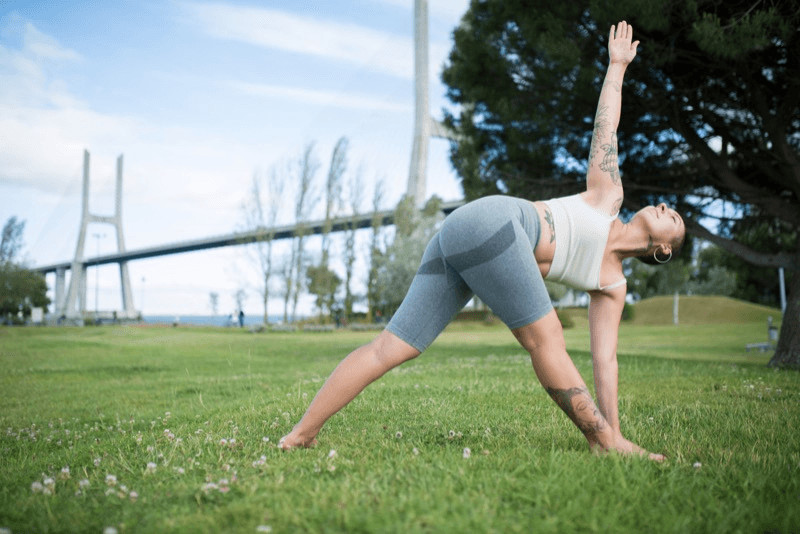
Preparatory Poses
Before diving into Utthita Trikonasana, or Triangle Pose, it’s wise to warm up. Focus on stretching your legs — especially the hamstrings and groin — and the sides of your body.
To prepare for Utthita Trikonasana, I start with Bound Angle and Gate Pose. Then, I work up to standing yoga poses like Warrior 2, Extended Side Angle, Reverse Warrior, and Wide-Legged Forward Fold.
These poses all target areas of the body vital to Triangle Pose. Be sure to check our library of yoga pose tutorials to review step-by-step instructions for each of these preparatory poses.
Common Variations
Ready for a challenge in Utthita Trikonasana? These common variations begin with the same base as the normal Triangle Pose, with slight alterations in the upper body, providing an extra stretch for your upper back muscles.
Bound Triangle Pose: From regular Utthita Trikonasana, bend your top arm, letting it drape behind your lower back. Wrap your arm around, reaching the tips of your fingers toward the crease of your lower hip. This variation helps open your chest and top shoulder. Revolved or Twisted Triangle Pose: Bring yourself into regular Utthita Trikonasana with your right leg in front. Bring your left palm to the floor (or a block) next to the inside of your right foot. Twist your spine, opening your chest to the right with your right arm reaching up.Counter Poses
To restore balance after you practice Utthita Trikonasana, I recommend forward-bending yoga poses such as Downward Facing Dog and Forward Fold (standing, seated, or wide-legged variation). The gentle inversion of these poses brings a sense of calm after the intensity of Triangle Pose.
Benefits of Practicing Utthita Trikonasana
Triangle Pose is a dynamic and engaging asana. With regular practice it brings numerous benefits for both body and mind.
Physical Benefits of Triangle Pose
Builds muscle strength: Triangle Pose strengthens your lower and upper back muscles, abdominals, glutes, inner thighs, and quadriceps. It’s a whole-body effort! Increases flexibility: This pose also stretches the inner thigh muscles, hamstrings, hip flexors, erector spinae (muscles along the spine), and sides of the body. Develops stability: Keeping your feet grounded with your legs spread wide apart strengthens the ligaments in the ankles and works the muscles in your feet. The balance and stability you cultivate in Triangle Pose transfer to other areas of your life, helping you feel sure-footed in all types of movement. Better posture: Utthita Trikonasana strengthens your spine, back muscles, and core — all areas that support optimal posture and help prevent back pain. It also counteracts the negative effect of slouching as you open your chest and shoulders.Mental and Holistic Perks
Enhanced focus and concentration: Holding a challenging position like Utthita Trikonasana demands your full attention as you become acutely aware of your alignment and breath. Boosts energy: As a dynamic pose, Utthita Trikonasana can increase blood circulation and energy flow throughout the body, producing a rejuvenating effect. Aids digestion: When you fold over your front leg, you gently compress and stimulate your abdominal organs, aiding digestion. Develops proprioception: When you use your body awareness to adjust your alignment, you’re honing your proprioception — the sense of where your body is in space. This skill is vital for maintaining coordination and poise in other areas of life. Builds self-confidence: Rising to the challenge of a demanding pose like Utthita Trikonasana takes determination. As you build physical strength with regular practice, you’ll also build mental fortitude.Incorporating Utthita Trikonasana into Your Yoga Practice
Utthita Trikonasana, or Extended Triangle Pose, is a cornerstone in many yoga sequences. Here are some ideas to use as inspiration for your next yoga sequence.
Use Triangle Pose in a sequence of standing yoga poses with a similar foundation. Warrior 2, Reverse Warrior, and Extended Side Angle all begin with the same lower body alignment so you can flow between them seamlessly. Focus on stretching and strengthing the sides of the body. Pair Utthita Trikonasana with poses like Gate, Side Plank, and Wild Thing stretch and strengthen the same body region. Flow through Utthita Trikonasana in my favorite sequence, the Moon Salutation.Expanding your movement library by learning new yoga poses is physically and mentally stimulating. Flowing through a dynamic sequence can improve your range of motion and deepen your appreciation for the interconnectedness of our brains and bodies.
Ready to start flowing? Check out Yogadownload.com’s free yoga classes. You’ll find a variety of Hatha, Vinyasa, and Iyengar-style classes that will help refine your alignment in Utthita Trikonasana.
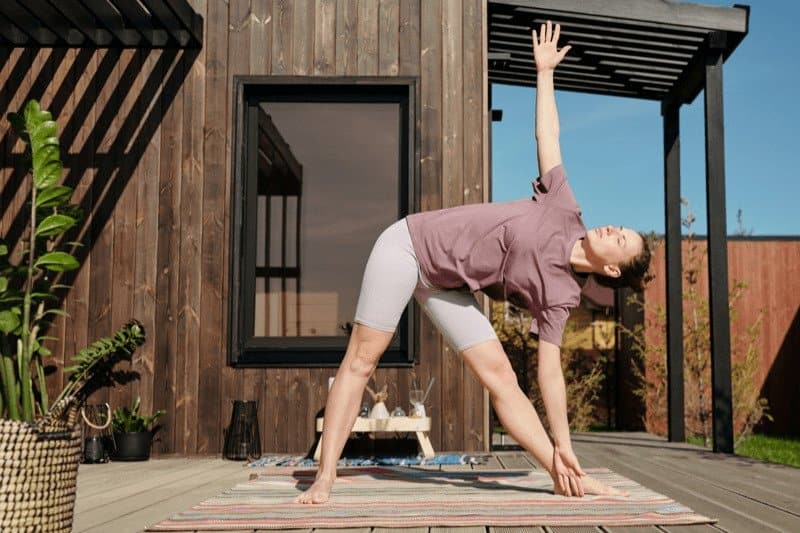
Closing Thoughts
Utthita Trikonasana, or Triangle Pose, perfectly embodies how we can cultivate inner balance and poise with our yoga practice. Creating a solid foundation with strong legs that root down into the earth allows your upper body to expand, arms outstretched, chest and heart open.
Despite mentioning many common mistakes, Triangle is one of my favorite poses to teach. It allows us to hone our body awareness and strive for proper alignment. Try to approach this asana with a sense of curiosity as you progress in your yoga journey.
With regular practice, the balance and stability you build in Utthita Trikonasana will seep into other areas of life, giving you the confidence to meet any challenge head-on.
Pop quiz! 🧘🤔
The common English name for Utthita Trikonasana is Triangle Pose.
Utthita Trikonasana is part of the Sun Salutation sequence.
Triangle Pose opens the chest and strengthens the spine.
Frequently Asked Questions
What is the Sanskrit name for Utthita Trikonasana and its origin?
Utthita Trikonasana, known as Extended Triangle Pose in English, originates from the Sanskrit words “utthita,” meaning extended, “trikona,” meaning triangle, and “asana,” meaning pose.
What are some contraindications for practicing Utthita Trikonasana?
Pregnant women and individuals with various types of injury should avoid Triangle Pose. If you experience chronic back pain or have issues in your body’s major joints, consult a doctor before attempting this pose.
What benefits does practicing Utthita Trikonasana offer?
Practicing this pose brings numerous benefits. It strengthens and stretches the legs, hip flexors, core, sides of the body, spine, and lower and upper back muscles. Practicing proper alignment builds focus and enhances your sense of body awareness.
What are some tips for incorporating Utthita Trikonasana into my yoga practice?
Use Triangle Pose in sequences with similar standing yoga poses like Warrior 2 and Wide-Legged Forward Fold. Strive for regular practice, at least 2 to 3 times per week, to build confidence, strength, and stability in this pose.
Thanks for your feedback!

 Troov
Troov 












